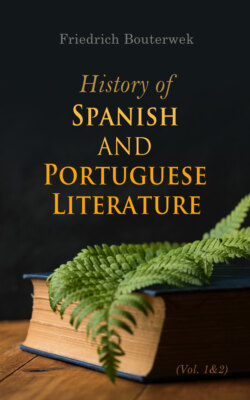Читать книгу History of Spanish and Portuguese Literature (Vol. 1&2) - Friedrich Bouterwek - Страница 41
На сайте Литреса книга снята с продажи.
MINOR SPANISH POETS DURING THE PERIOD OF THIS SECTION, VIZ. ACUÑA—CETINA—PADILLA—GIL POLO.
ОглавлениеTable of Contents
Fernando de Acuña, one of the first of the distinguished men who became the disciples of Boscan and Garcilaso, was of Portuguese extraction, but born in Madrid, probably about the beginning of the sixteenth century.243 He signalized himself in the campaigns of Charles V. and was also a person of consideration at the court of that monarch. He lived on terms of intimate friendship with Garcilaso de la Vega, whom he survived for a considerable period, for it appears that his death did not take place until the year 1580. He proved his taste for classical literature by translations and imitations. He paraphrased in iambic blank verse, several passages from Ovid’s Metamorphoses, and among the rest, the dispute between Ajax and Ulysses for the arms of Achilles, in very correct and harmonious language. He likewise translated some of the Heroides of the same author in tercets. In his own sonnets, cancions, and elegies, which are replete with sentiment and grace, it is easy to recognise a poet who successfully laboured to attain classical elegance of style.244 He was also one of the first poets, who, by composing in short strophes, endeavoured to form an intermediate style between the Italian canzone and the Spanish cancion.245
Gutierre de Cetina is less known, though there is no doubt of his having lived about the same period, as he is mentioned by Herrera in his Commentary on the Works of Garcilaso. He was, like Herrera, a native of Seville; and having removed to Madrid, was there invested with an ecclesiastical dignity. Few of his poems have been printed;246 but from those few it is obvious that he had a fair chance of becoming the Anacreon of Spain. That glory, however, was reserved for Villegas. Still Gutierre de Cetina’s imitations of the anacreontic style are not without their share of sweetness and grace; and they are moreover remarkable as being the first productions in the class to which they belong.247 His madrigals also seem to have had no prototype in Spanish literature.248 In his canciones, however, the romantic enthusiasm occasionally degenerates into absurdity.249
Pedro do Padilla, a knight of the spiritual order of St. Jago, must be ranked in the same class with Gutierre. He vied with Garcilaso in pastoral poetry; and in order to conciliate the partizans of both the old and the new styles, he introduced alternately in the same eclogue the Italian and the ancient Spanish metres.250 His poetry is still esteemed in Spain. He followed the old national custom by making the events connected with the war in the Netherlands serve as subjects for romances.251
But a poet still more celebrated, and in a great degree indebted for his fame to the immoderate encomium bestowed upon him by the pen of Cervantes, is Gaspar Gil Polo, a native of Valencia, who continued and concluded Montemayor’s Diana under the title of La Diana enamorada.252 A continuation of this pastoral romance had previously been undertaken by a writer named Perez; but without success. Gil Polo in one respect effected more than did Montemayor himself; but in point of invention he is inferior, notwithstanding the faults of the original plan. After Sireno has been cured of his love by the sage Felicia, Gil Polo makes the passion of Diana revive, and renders her more unhappy for Sireno’s sake, than he had previously been for hers. Thus the romantic story is reversed; but the new relations under which it now appears are few. In the sequel the aid of the sage Felicia is again obtained, and she finally unites the long separated lovers. The narrative style in the prose portion of the romance presents a very correct imitation of Montemayor; but neither the merit of this imitation, nor the continuation of the metaphysical reflections on love, with which the romance is interspersed, would have gained for Gil Polo the approbation of the critic. What must have raised him higher than Montemayor in the estimation of such a judge as Cervantes, is the precision and clearness of the ideas, and the perfect polish of style in the poetic part of the romance. Montemayor has often indulged in too subtle or sophistical plays of wit. Gil Polo in painting the feelings has exercised a sounder judgment, without, however, descending to the coldness of prose. His sonnets may be regarded as models; for he has succeeded in combining the unity of ideas, which ought to distinguish that species of composition, with the most elegant rounding and regularity of structure.253 In his canciones he has occasionally, for the sake of variety, imitated the Provençal rhymes (rimas Provenzales) with such happy dexterity, that the reader might fancy himself perusing some of the best opera songs, though no such thing as an opera then existed.254 In like manner, he endeavoured to naturalize the metrical structure of French verse (rimas Franceses) in the Spanish language, upon which the burthen of alexandrines had already been inflicted.255 In compliment to the old Spanish taste, he bedecked his romance with a profusion of versified riddles (preguntas,) which are, for the most part, so exceedingly dull, that it is difficult to conceive how they could be endured by a man of Gil Polo’s talent.256 In honour of Valencia, his native city, he composed a poem, in which the genius of the little river Turia is made to sing the praises of the celebrated men to whom Valencia had given birth. This song of Turia (Canto de Turia) has found patriotic commentators, without whose laborious explanations it would have been unintelligible to foreign readers.257
